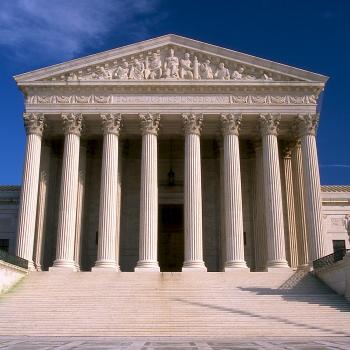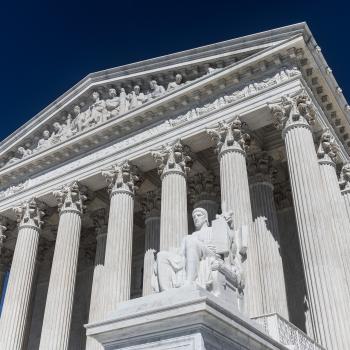Forbid Them Not, pp. 147-179, chapter 12
It is May 23rd, the day of the hearing. While I lean on summary, this post is going to be a long one. This shouldn’t be surprising; this chapter takes up over 30 pages. I considered splitting this chapter into several sections, but ultimately decided that the trial portions weren’t interesting enough to justify that.
This is how Farris begins the chapter:
Deputy Micah Daniels called for reinforcements early. He would need three extra sheriff’s officers to serve as bailiffs. He wanted to ask for five, but Judge Holman told him that the hordes were only reporters and not accused felons—although, Holman sardonically added, it was hard to tell the difference by the way they dressed. Daniels had rolled that comment over in his mind at least fifty times as he issued passes to the various members of the press corps that started lining up next to the folding table he had installed at the bottom of the outside steps.
Daniels began a mental game of assigning felony charges to each of the reporters as he signs dither passes. Print reporters were generally burglars. Radio reporters were armed robbers. On-camera television personalities were embezzlers. Every cameraman wandering around the courthouse square was an accused rapist, and this jury of one was almost certain to convict.
Yeah, that happened. It reminds me of Wally, in Farris’ other book, who delivered court summons and other court papers and took pleasure in calling feminist lawyers “Mrs.”
Anyway, there are four issues at play in this hearing:
- Corporal punishment
- Homeschooling/removing a child from sex ed
- Teaching religions intolerance
- The standing of the CDF and the NEA
Judge Holman begins by summarizing each issue and to ensure that both sides are in agreement on the basic facts of the case. This case, he says, hinges not on facts but on “the meaning and applicability of the law.”
All parties agree that the Thomases and Garvises use corporal punishment in a manner considered legally appropriate before the treaty; that Layton, who is being homeschooled, is doing well socially, emotionally, and academically; that the children are being taught that Christianity is the only way to heaven, which “contains an inherent criticism of other religions”; and that the CDF and the NEA are registered U.N. agents. Wait. What?
Let’s give that one a little bit of detail:
“I find that both the National Education Association and the Children’s Defense Fund are, as alleged, properly qualified non-governmental organizations recognized by the United Nations. … I assume there is no objection to this finding. Correct, Mr. Stone?”
“Agreed, Your Honor. Both are affiliated with the UN, as the petitions alleges.”
Hang on a moment. Cooper’s “affiliated with” comment made me decide to actually look this up. Guess what? While I wouldn’t have any problem with the CDF or NEA being on some sort of U.N. list of NGOs and working with the U.N., I cannot find either of them on any list of NGOs registered with, consulting with, or otherwise affiliated with the U.N.
I had assumed that these organizations were recognized by the U.N. as Farris claims, but I’m starting to wonder if this claim is actually wrapped up in right-wing conspiracy theories. If Farris believes that the U.N. is bent on world domination and also believes that the CDF and NAE are anti-family organizations bent on destroying bible-believing Christianity, it would make sense to posit that the CDF and the NAE would be in the U.N.’s pocket, or even somehow part of it.
Judge Holman starts, though, by calling Laura up and assuring her that no one will take any action against her involving her school superiors or anyone else. Laura is nervous to be called up in front of the huge crowd of lawyers, parents, friends, and reporters in the courtroom, but is pleased to have this reassurance.
“Thank you so very much, Your Honor,” Laura said, brushing her hair nervously away from her face.
As she did, Cooper noticed the diamond ring on her left hand. The heat of disappointment made the room suddenly seem warm and stifling. He tried to force himself to refocus on the hearing, but instead his eyes wondered through the audience until he noted Terry Pipkin stating next to the empty spot where Laura had been sitting.
…
All returned to their seats. To Cooper, each step toward counsel table felt as if he was walking with a fifty-pound weight on each leg. And his head seemed to pound. Oh, Lord God, please help me focus on this case, he whispered in his soul.
If we needed any further evidence that Cooper should not be the one arguing this case, we have it there. His personal involvement with these individuals—or, in particular, with Laura—is getting in the way of his ability to be a competent lawyer. Cooper will spend the rest of the hearing trying not to think about Laura.
Now! Time to get into the case! Judge Holman gives Randolph the first shot on each point, then Cooper, then a short rebuttal by Randolph. They go through the four issues one at a time, in order.
“Very well, Your Honor,” Suskins said, as he stood. His silver suit was a perfect match to his hair color. One might also guess that his pale blue tie had been dyed to match his eyes or that he had purchased color contacts just for the occasion.
Ya’ll have fun with that one.
Corporal Punishment
Randolph starts his oral arguments on corporal punishment by quoting from Article 19 of the U.N. Convention on the Rights of the Child. I was going to type the line he quotes here from the book, but I decided to take the easy way out and look up the passage in the Convention and copy and paste. Boy am I glad that I did. Farris got the quote wrong.
The Convention says that states parties shall:
“take all appropriate legislative, administrative, social and educational measures to protect the child from all forms of physical or mental violence.”
Randolph says the Convention says states party to the treaty shall:
“take all appropriate legislative, administrative, social and educational measures to protect the child from all forms of corporal or mental violence.”
The fact that Randolph misstated what the treaty says is never brought up and does not appear to be a plot point. Instead, this appears to be all Farris. He may have simply mistyped. But, there is also another possible explanation.
Spanking advocates constantly argue that spanking is not “physical violence.” It is, they say, nothing of the sort. Farris, though, is arguing that the Convention would bar spanking, based on the passage above. Changing the term from “physical” to “corporal” would allow Farris to draw a clear line between the Convention and a spanking ban despite spanking advocates’ insistence that spanking is not physical violence.
Either way, Farris never tries to argue that the Convention does not ban spanking.
I am running into something that is an ongoing problem here—everyone is incompetent. Randolph quotes the above line from the Convention and then argues that this section constitutes a “self-executing” ban on spanking—that the Convention itself automatically bans spanking—seemingly without any need for the “appropriate legislative, administrative, social and educational” measures called for in the very line he quotes.
Cooper says the treaty is not self-executing because the Senate did not mean for it to be self-executing. He states that many Senators, in the debate over the treaty, indicated that they believed that even under the treaty, banning spanking would require passing laws. Randolph responds that for the Senate to designate a portion of a treaty to be non-self-executiong, it would need to take a vote and make a formal amendment, or “reservation,” to the treaty, which makes sense.
Through all of this, literally no one addresses the fact that the treaty states that:
“States Parties shall take all appropriate legislative, administrative, social and educational measures to protect the child from all forms of physical or mental violence.”
The treaty absolutely does not say “spanking is banned.” It says states parties will take steps to protect children from physical violence. Those steps might include banning spanking, but only by means of laws. How a nation interprets this provision, and how they go about curbing violence against children, is going to vary from culture to culture. But there is no way to read the line above and conclude that it is a self-executing ban on spanking, without any need for laws or policies.
And I say all this as a person who is anti-spanking.
Homeschooling
Randolph summarizes Article 29 of the Convention, including what he describes as “five criteria that all education must meet, including things like teaching tolerance (provisions listed in (a) through (e) under section 1 of Article 29).
Article 29 reads in full as follows:
1. States Parties agree that the education of the child shall be directed to:
(a) The development of the child’s personality, talents and mental and physical abilities to their fullest potential;
(b) The development of respect for human rights and fundamental freedoms, and for the principles enshrined in the Charter of the United Nations;
(c) The development of respect for the child’s parents, his or her own cultural identity, language and values, for the national values of the country in which the child is living, the country from which he or she may originate, and for civilizations different from his or her own;
(d) The preparation of the child for responsible life in a free society, in the spirit of understanding, peace, tolerance, equality of sexes, and friendship among all peoples, ethnic, national and religious groups and persons of indigenous origin;
(e) The development of respect for the natural environment.
2. No part of the present article or article 28 shall be construed so as to interfere with the liberty of individuals and bodies to establish and direct educational institutions, subject always to the observance of the principle set forth in paragraph 1 of the present article and to the requirements that the education given in such institutions shall conform to such minimum standards as may be laid down by the State.
Randolph claims that Layton’s homeschool is in violation of Article 29 because:
- it is not an “educational institution” (in some states homeschools are considered private schools, and in other states homeschooled operate as satellites of private schools, so I do not find this argument convincing);
- it does not have to conform to any “minimum standards” laid down by the state (Layton’s homeschool does conform to the minimum standards laid down by the state, those standards are just super low, so, again, unconvincing);
- there is no proof that it is teaching respect for tolerance, etc., as required in (a) through (e) above.
Farris does not actually respond to Randolph’s points. Instead, he argues that “a treaty may never violate the express constitutional rights of Americans.”
He cites Pierce v. Society of Sisters, which struck down a state ban on private schools and upheld “the liberty of parents and guardians to direct the upbringing and education of children under their control.” But the Court in Pierce never held that this right was not subject to any government involvement at all. Indeed, the ruling in Pierce included this statement:
No question is raised concerning the power of the State reasonably to regulate all schools, to inspect, supervise and examine them, their teachers and pupils; to require that all children of proper age attend some school, that teachers shall be of good moral character and patriotic disposition, that certain studies plainly essential to good citizenship must be taught, and that nothing be taught which is manifestly inimical to the public welfare.
Farris tends to be good at ignoring that bit.
In sum, Farris argues that the treaty cannot ban homeschooling because (1) a treaty cannot violate the constitutional rights of Americans; (2) in Pierce the Court held that parents have the right to direct their children’s education, finding it a “reserved right” of the Constitution; and (3) the right to direct the education of a child includes the right to homeschool.
Judge Holman objects.
“But, Counsel, what do you say about Missouri v. Holland? Mr. Suskins points out with some force in his brief that if we are talking about an unwritten constitutional right, then a treaty wins. The Missouri case held that a state’ reserved rights under the Tenth Amendment took second place behind a treaty. So, wouldn’t a parent’s reserved right to direct a child’s education also take second place to a treaty?”
Cooper pondered the content of Suskins’ argument for several seconds before answering. “Your Honor, nothing occurs to me on how to answer that question, other than just saying that Missouri v. Holland was a wrong decision and it should be overturned.”
“Perhaps it should be, Counsel, but you need to talk to the United States Supreme Court about that one. They made that particular decision, and they re the only ones who can reverse it.”
Cooper changes gears and argues what he probably should have from the beginning—that the treaty is “non-self executing” with regard to its educational provisions. Randolph argues this isn’t true, but Cooper says it clearly is, since Randolph keeps saying that under the treaty the state is obligated to have laws regulating homeschooling, and if laws are required it can’t be self-executing. I feel like Cooper should have started with this argument; it’s the stronger one.
Emily’s Sex Ed
When the children’s guardian ad litem, Rachel Hennessey, is asked her opinion on both children’s education, she says that Layton is doing well “academically, socially, and emotionally” in his homeschool, but that:
“Other than homophobia and a desire to enforce somewhat Puritanical ideas relative to reproductive matters, I see no motive for removing Emily [from sex education].”
What does this class teach, given that Laura is Emily’s teacher? Does Laura teach the sex education section? Or does someone else come in and do it? And if so, if the program is bad enough for Emily’s parents to pull her, how is Laura ok with that? I suspect that the program is not at all objectionable, but that Emily’s parents read Focus on the Family and follow Concerned Women for America and have become convinced that these classes are condom-laced porn sessions.
This is never explained.
The Best Interests of the Child Standard
Rachel says that Layton’s homeschool should be reviewed annually, and that she hopes the court will opt for ongoing supervision. Judge Holman asks how this is possible if the family is doing nothing wrong currently, and Rachel says:
“Your Honor, the reason is pretty simple. Under the law before the treaty, the best interest of the child standard was part of the law that we applied only to broken families. If there was a conviction of child abuse, or if there was a divorce, then the court had to decide what was in the best interest of the child.
“But now, the treaty implies that the government has the duty to intervene for the best interests of every child and not just children from broken homes.”
Randolph says the government better be ready to hire a whole new slew of juvenile judges if that is indeed the case. I would really love to see a family law or children’s rights lawyer in Europe or somewhere else where the Convention is in effect respond to this. Rachel’s claim, here, plays a big role in right wing fear mongering about the Convention.
In the U.S., the best interests of the child standard is applied only in court proceedings—child welfare cases, custody disputes, etc. As a result, when Farris thinks of expanding it, he automatically assumes that means expanding the number of court proceedings to involve growing numbers of children. But I don’t think that’s what the Convention does—I think it instead applies the standard to additional bodies, such as the legislature (which is in fact what it states).
1. In all actions concerning children, whether undertaken by public or private social welfare institutions, courts of law, administrative authorities or legislative bodies, the best interests of the child shall be a primary consideration.
The “best interests” standard can be expanded without this meaning endless litigation or judicial oversight of every family with a child in part because the Convention sees being raised by one’s parents—being taught one’s own culture and beliefs and being guided by one’s parents—itself as being in the “best interests” of the child.
Farris blatantly ignores the many times the Convention affirms the right of the parent to direct the upbringing of the child. The Convention affirms the right of the child to be raised by his parent, and the right of the child to learn the cultural and religious beliefs of his parents and his religious or ethnic community. These provisions are designed to counteract the systematic undermining of indigenous families in many settler societies, but they ought to apply here as well.
Farris argues that the Convention is unconstitutional because it undermines parents’ rights, seemingly without realizing that in many sections, the Convention actually undergirds parents’ rights. Farris is so busy fighting the Convention that he does not seem to realize that he could use some of its provisions, if he so chose, as a basis for his arguments.
Courtroom Hijinks
At this point, the court goes into recess and this happens:
Doug Garvis tapped Cooper on the shoulder. “Is there any reason that Emily has to listen to this?”
Cooper saw the obvious distress in his face. “Let me send a note to the judge. I think he will excuse her and Layton. This is not about them individually, in the normal sense of the word.”
WHAT.
What in the world were Emily and Layton doing in the courtroom? I have been to child welfare proceedings in juvenile court before. I have never seen a case where the child was present. And here Farris suggests that Emily and Layton aren’t merely present because their parents are dragging them here—as I had assumed—but rather because they are required to be here. No. No, no, and no. This is not how that works. How does Farris not know that this is not how this works?
Anyway, since they’re in recess, Cooper is hiding from Laura. He decided to hire from Laura by staying up at the front of the court as everyone leaves for the recess, and the result is that the press immediately goes for the parents. The Garvises and Thomases say that they’d rather the press talk to their lawyer, but where is he? Oh right, he’s hiding from Laura. Because God called him to take this case.
So they send Laura back in to get him. Well. That worked out just great. The two have an awkward moment where Cooper congratulates Laura on her engagement (he couldn’t just ignore it and be professional?) and she awkwardly thanks him and they’re all awkward and then finally Cooper goes to talk to the reporters.
Fun.
Teaching religious intolerance
Randolph gets up and gives this speech:
“If we are to live in a world community with peace, human rights, and reasonable harmony, then we must put an end to the era in which one religion thinks that it has an exclusive corner on the truth. The vast majority of people are willing to simply say, ‘This is what I believe. I do not intend to suggest that you must believe the same.'”
This isn’t a terrible speech, as speeches go. This is just a weird place for it. This is the sort of speech that ought to be made with the intent of changing minds and views, and not in the context of litigation.
Deanna is uncomfortable.
Deanna closed her eyes and wished very hard to disappear off the faec of the earth. She then amended her wish and willed the disappearance of the rest of her family with her. A mental image of pioneer life in a log cabin about 150 years earlier suddenly seemed very inviting.
And dysentery. Also dysentery.
Randolph cites Article 14 of the Convention:
“[The third paragraph of Article 14] teaches that religious belief may be limited if ‘necessary to protect … the fundamental rights and freedoms of others.’ We believe this implies a duty to refrain from teaching that Islam is wrong or Buddhism is wrong or that Jews need to accept Jesus. An attack on the religious freedom on others is inherent in such an exclusivist approach to matters of faith.”
This argument, once again, makes no sense.
Let’s look at what Article 14 actually says:
1. States Parties shall respect the right of the child to freedom of thought, conscience and religion.
2. States Parties shall respect the rights and duties of the parents and, when applicable, legal guardians, to provide direction to the child in the exercise of his or her right in a manner consistent with the evolving capacities of the child.
3. Freedom to manifest one’s religion or beliefs may be subject only to such limitations as are prescribed by law and are necessary to protect public safety, order, health or morals, or the fundamental rights and freedoms of others.
Article 14 states that the state must respect “the rights and duties of the parents” to “provide direction to the child in the exercise of his or her” right [to freedom of thought, conscience and religion]. In other words, the state has to respect the parent’s right to provide religious instruction and direction to the child.
Additionally, I am fairly certain that the third paragraph applies to the child, and not to the parent—the child’s freedom to manifest their religion or beliefs maybe subject only to such limitations “as are prescribed by law and are necessary to protect public safety” etc. Farris appears to think this means the parent’s right.
The law in this book is such a jumble that it’s getting hard to cover it in any way that makes sense. In the future, I may lean even further on summary of parts like these, and focus instead on the development and interaction of the characters.
Cooper once again says once again that treaties cannot override Constitutional rights, and here he cites the First Amendment. Judge Holman asks how Cooper responds to Randolph’s argument “to the effect that religious freedom in the Constitution doesn’t decide whose [religious freedom] is to prevail, the child’s or the parent’s?”
Cooper says that “we must interpret the United States Constitution according to the spirit in which it was written” and that “George Mason, who lobbied for the Bill of Rights, or Patrick Henry, whose insistence that the Constitution not be ratified because of the absence of a bill of rights” would have answered “that parents have the right to direct the religious upbringing of their children and no government should ever be allowed to interfere in matters of belief.”
The founders would have said a lot of other things as well.
Unsurprisingly, Cooper also argues that the treaty is not self-executing, but this time he actually points to the Convention text, which states that “freedom to manifest one’s religion or beliefs” should be “subject only to such limitations as are prescribed by law.” He would be right, except that no one is interpreting Article 14 in a way that makes any sense.
The Evil United Nations
Randolph adds this:
“Article 29 also requires instruction in respect for the principles of the United Nations. The instruction of this church is that world government agencies are dangerous and must be watched, lest they become a direct instrument for Satan, who will try to use them to dominate the earth.”
What did the Convention actually say?
1. States Parties agree that the education of the child shall be directed to:
…
(b) The development of respect for human rights and fundamental freedoms, and for the principles enshrined in the Charter of the United Nations;
…
Randolph asks Judge Holman to bar the parents “from teaching that world government somehow relates to Satan.”
I’m suddenly curious. Just what are “the principles enshrined in the Charter of the United Nations”? After all, this passage does not say that childcare’s education should be directed to respect for the United Nations. It says that children’s education should be directed to respect for the principles enshrined in the Charter of the United Nations. Does that mean respect for human rights and world peace? Or does it mean respect for a one-world government?
Judge Holman’s Ruling
Judge Holman makes his ruling on the spot. He says that with regards to religious intolerance and homeschooling, he is convinced that the treaty is not self-executing. He tells Randolph that his claims about what the treaty mandates may indeed be correct, but that he must pass laws to bar parents and churches from teaching religious intolerance to their children, or to further regulate homeschooling. Judge Holman finds, however, that the treaty does ban spanking outright.
Therefore, Judge Holman orders the Thomases and the Garvises to cease spanking Emily and Layton immediately.
“Mr. and Mrs. Thomas and Mr. and Mrs. Garvis, this gives me no pleasure. My parents spanked me, and I spanked my children when they need dit. I turned out well and so did my kids, and I am sure that you are good and loving parents. So there is no condemnation at all in my order. But I am required by law to order you to stop all spanking of your children, and such an order will indeed be entered.”
This is going to become a problem, because Deanna isn’t going to be able to stop herself from spanking Layton. That is how central spanking is to fundamentalist parenting.
“This court is adjourned,” Daniels proclaimed with his hand on his gun, lest any of the ‘felons’ decided to charge the bench.”
And that is the end of this chapter.
I have a Patreon! Please support my writing!










